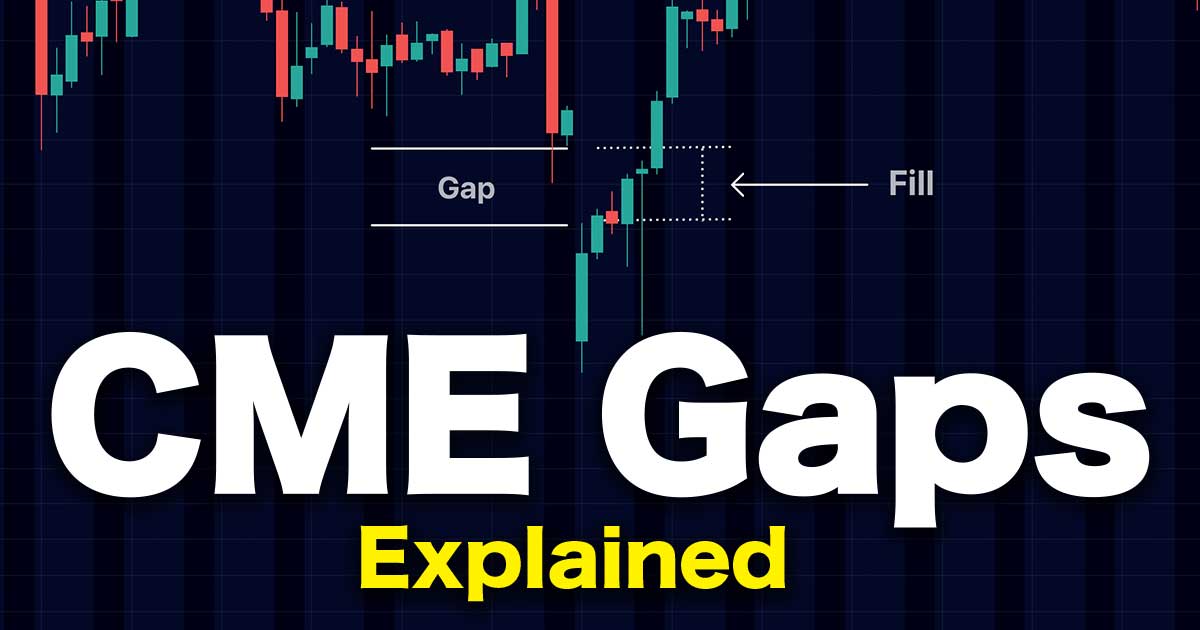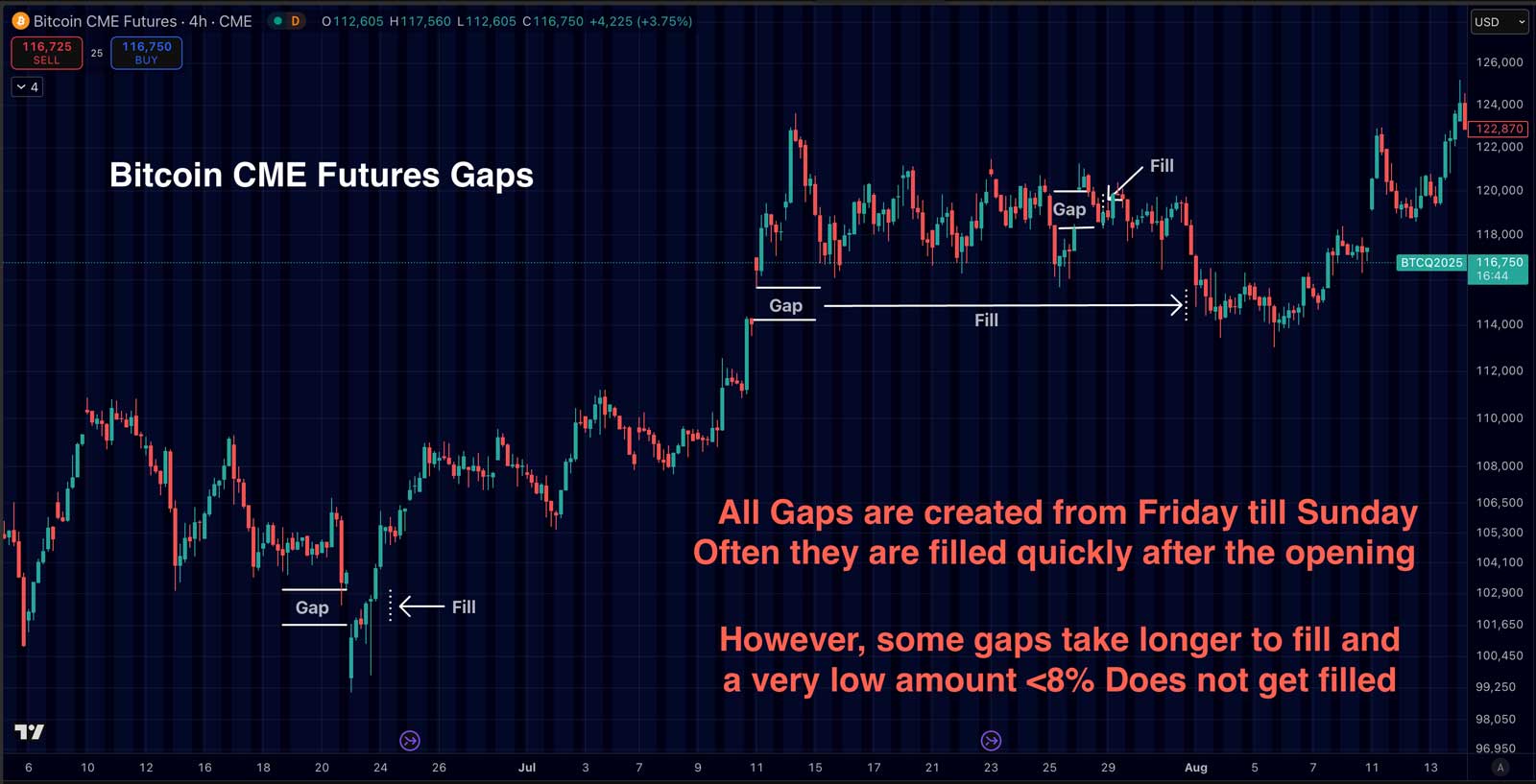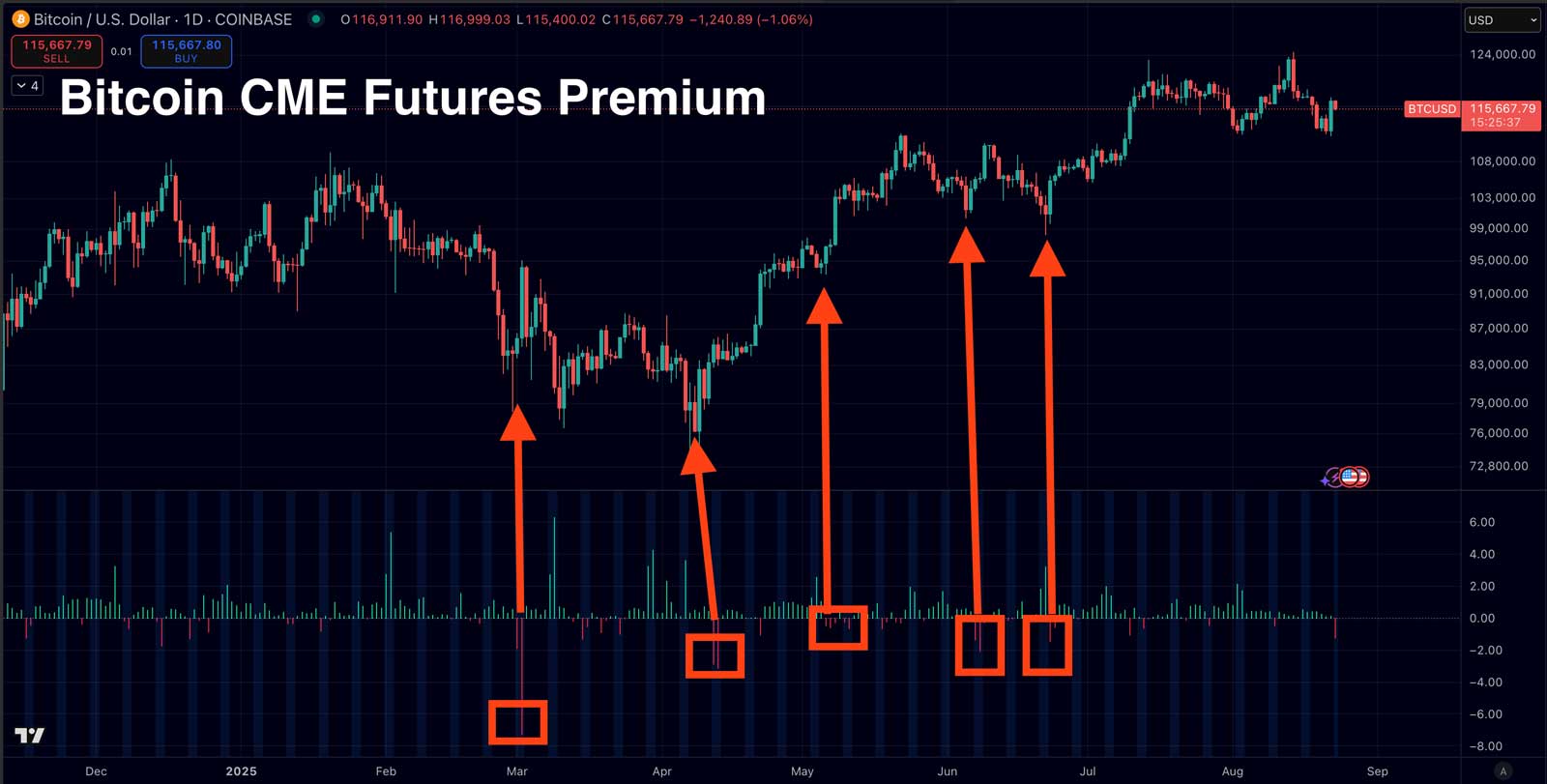Bitcoin CME Gaps and CME Trading Strategy Explained
 Bitcoin CME Gaps tend to get filled, is a sentence you’ve probably heard from technical analysts. But what are CME Gaps? And why do CME gaps get filled? And is this something that is only present with Bitcoin, or is this a phenomenon visible on other markets? In this article, we’ll dive into all of these questions, and we will provide a step-by-step strategic way you can use the Bitcoin CME gaps into your advantage.
Bitcoin CME Gaps tend to get filled, is a sentence you’ve probably heard from technical analysts. But what are CME Gaps? And why do CME gaps get filled? And is this something that is only present with Bitcoin, or is this a phenomenon visible on other markets? In this article, we’ll dive into all of these questions, and we will provide a step-by-step strategic way you can use the Bitcoin CME gaps into your advantage.
What is the Bitcoin CME futures gap?
In short, it’s the gap that forms when Bitcoin CME futures stop trading on Friday and then reopen on Sunday night at a different price.
Unlike traditional finance (stocks), the crypto markets never close; they trade 24/7, including weekends. However, when Bitcoin is listed on traditional finance platforms like the CME (Chicago Mercantile Exchange), it follows their trading schedule and closes over the weekend, just like the S&P 500.
Since Bitcoin continues to trade globally on crypto exchanges during that time, price fluctuations often occur while CME is closed. When CME reopens on Sunday evening (depending on your timezone), the opening price may differ significantly from the Friday close. This creates a “gap” on the CME Bitcoin chart.
In traditional finance, gaps are a common phenomenon and are known to have a high probability of being “filled,” meaning that price eventually moves back to close the gap. Traders often watch these gaps closely, as they can provide useful signals for short-term price action.
Why does the Bitcoin CME gap get filled?
This is a question that has puzzled traders for years, not only in Bitcoin but also in traditional finance. Statistically, there’s a very high probability that price gaps get filled. In fact, almost every gap that appears eventually closes, often much sooner than later.
Some argue it’s just a “coincidence” caused by market volatility. But if it were pure chance, could the accuracy really be this high?
Another explanation points to liquidity. Weekend price action typically has lower liquidity compared to weekdays, which makes weekend moves less significant. When institutional liquidity returns on Monday, the market often reverts toward Friday’s closing levels to restore balance.
There’s also the theory of weekend manipulation. With thinner order books during weekends, it’s easier for large players or market makers to push prices around. However, such artificial moves can only extend so far before the market gravitates back to its “true” price once normal trading resumes.
But in the end, does it really matter why it happens? Traders just need to know a statistical edge in order to use it in their trading strategy. So let’s have a look at how you can use this in your trading strategy.
CME Gaps Chart Example
 In the chart above you can see 3 examples of CME Futures gaps that mostly got filled shortly after they were created. The 1st gap got filled on the same day that the market opened again. The 2nd gap took a little bit longer to close (multiple days), but eventually closed as well. The 3rd gap was also filled almost instantly after the market reopened. This is a good example showing the behaviour of the price in relation to the CME gaps. Most get filled almost instantly, while others take a bit longer.
In the chart above you can see 3 examples of CME Futures gaps that mostly got filled shortly after they were created. The 1st gap got filled on the same day that the market opened again. The 2nd gap took a little bit longer to close (multiple days), but eventually closed as well. The 3rd gap was also filled almost instantly after the market reopened. This is a good example showing the behaviour of the price in relation to the CME gaps. Most get filled almost instantly, while others take a bit longer.
CME Futures Gap Trading Strategy
There are different ways you can use the CME futures gaps in your trading strategy. Let’s have a look at a couple of examples.
CME Divergence Trading Strategy
One way to trade the CME Gap is to look for a divergence during weekend price action. So you look at the CME price close on Friday, and you compare that with the exchange that you are trading on (This is because the price of CME futures often is slightly different than other exchanges). And when the price diverges for example 1% or more, you can open a trade in the direction of the price close. Small changes in price can result in big profits, especially when leverage is used. But be careful, with increased leverage also comes increased risk. Another way to open a trade is to build a position slowly over the weekend, so, for example, open the trade with a 1% divergence, adding to it with a 2% divergence etc.
Use CME Gap for Entry
Another way you can use the CME gap to your advantage is by adjusting your entry. Weekend price action often goes with lower liquidity and, therefore, is less significant. Many traders do not like to have positions open during the weekend. So let’s say you’re interested in shorting the market, but it’s Friday. It could be better if you’d wait during the weekend for 2 reasons:
- If the price diverges higher, you have a better entry
- If the price drops, high chance you will still get the same entry after opening by filling the gap
This presents a low-risk approach to opening a position and gives you peace of mind during the weekend.
Bitcoin CME Premium Index
Many traders are not aware that you can use the data from CME futures in other ways, too. Just as we’re watching the premium index, which is the difference of price between the spot and futures market, to watch for the market sentiment. You can also view the price difference of the CME futures to that of other exchanges. When the price of CME futures is lower than the price of regular exchanges, this shows that institutions are panicking and often coincides with a low in the Bitcoin price, which is followed by a rally.
 In the chart above, you can see that every time it gets into negative territory, the price starts to rally. You can view this indicator on TradingView.
In the chart above, you can see that every time it gets into negative territory, the price starts to rally. You can view this indicator on TradingView.
Conclusion: How to Trade Bitcoin CME Gaps Effectively
Bitcoin CME gaps are one of those rare chart patterns that consistently give traders a statistical edge. While not every gap closes instantly, history shows that most eventually do, often sooner rather than later. Whether you use them as a signal to time entries, manage weekend risk, or spot institutional sentiment, CME gaps can be a valuable addition to your trading toolkit.
The key takeaway is simple: gaps are not random noise, but a recurring feature of the Bitcoin market that traders can learn to anticipate and benefit from. As always, risk management is crucial, especially when using leverage or building weekend positions.
If you want to put this strategy into practice, the best way is to trade on a reliable exchange that gives you access to Bitcoin futures with deep liquidity to avoid slippage.
Join Bybit today and get up to $30’000 in bonuses.
FAQ: Bitcoin CME Gaps
What is a Bitcoin CME gap?
A Bitcoin CME gap is the price difference that appears on the CME (Chicago Mercantile Exchange) Bitcoin futures chart when trading closes on Friday and reopens on Sunday at a different price. Since crypto trades 24/7, the CME chart often shows gaps caused by weekend price movements.
Why do CME gaps get filled?
Most CME gaps get filled because weekend price action happens with lower liquidity, and when institutional trading resumes, the market often reverts to Friday’s closing price. This creates a statistical tendency for the gap to close.
Do all Bitcoin CME gaps get filled?
Not all gaps close immediately, but historically, the majority of CME gaps eventually do get filled. Some may close within hours after the market reopens, while others can take days or even weeks.
Can you trade Bitcoin CME gaps?
Yes, traders often use CME gaps as part of their strategy. Common approaches include entering positions when the gap opens, waiting for price reversion, or using divergence between CME and crypto exchanges to time entries.
Is trading CME gaps profitable?
Trading CME gaps can be profitable because of their high probability of being filled. However, like all strategies, it comes with risks, especially when using leverage. Proper risk management is essential.
Related Articles:
- Bybit EU’s $5,000 Deposit Bonus Explained
- How to Use a Decentralized Exchange (DEX) Within a Company Setup
- Bitcoin Moon Cycle Strategy: How Lunar Phases May Predict Price Moves